

beveridgean unemployment gap P ascal Michaillat (Brown) Emmanuel Saez (Berkeley)
unemployment gap: key for macro policies • US government mandate is to achieve “full employment” – Humphrey–Hawkins Full Employment Act of 1978 – unemployment gap = distance from “full employment” • optimal macro policies depend on distance from efficiency – monetary policy, fiscal policy, labor subsidies/taxes – unemployment gap = distance from efficiency
challenges in measuring unemployment gap 1. statistical approach (CBO) – trend unemployment generally not efficient 2. Phillips-curve approach – based on inflation dynamics but not welfare 3. our approach: based on welfare in matching model – same welfare concept as Hosios (1990) – but applicable to any matching model – and implementable with observable statistics
overview of the method: 2009–2019 5% 4% 2019:Q3 Vacancy rate 3% 2% 2010:Q1 1% 2% 4% 6% 8% 10% Unemployment rate
overview of the method: 2009–2019 Beveridge curve 5% 4% Vacancy rate 3% 2% 1% 2% 4% 6% 8% 10% Unemployment rate
overview of the method: 2009–2019 Beveridge curve 5% 4% Vacancy rate 3% 2% Iso-welfare curve 1% 2% 4% 6% 8% 10% Unemployment rate
overview of the method: 2009–2019 Beveridge curve 5% u* = 3.7% 4% Vacancy rate 3% 2% Iso-welfare curve 1% 2% 4% 6% 8% 10% Unemployment rate
theory
beveridge curve • Beveridge curve: v ( u ) – v : vacancy rate – u : unemployment rate – decreasing, convex • present in many countries (Elbsy, Michaels, Ratner 2015) • present in many models – matching (Diamond-Mortensen-Pissarides + variants) – mismatch (Shimer 2007) – stock-flow matching (Ebrahimy, Shimer 2010)
social welfare • recruiting cost: ρ workers / vacancy • social value of unemployment / employment: z • social welfare (Hosios 1990): ( 1 − u ) + u · z − ρ · v ( u ) • first-order condition wrt u to maximize welfare: − 1 + z − ρ · v ′ ( u ) = 0 v ′ ( u ) = − 1 − z ρ
efficient unemployment & business cycles Beveridge curve: v ( u ) Vacancy rate u* Iso-welfare curve: slope = -(1 - z )/ ρ 0 Unemployment rate
efficient unemployment & business cycles Beveridge Vacancy rate u > u* Slump Iso-welfare 0 Unemployment rate
efficient unemployment & business cycles Beveridge Vacancy rate Boom u < u* Iso-welfare 0 Unemployment rate
costlier recruiting Beveridge Vacancy rate u* Iso-welfare 0 Unemployment rate
costlier unemployment Beveridge Vacancy rate u* Iso-welfare 0 Unemployment rate
worse mismatch Beveridge Vacancy rate u* Iso-welfare 0 Unemployment rate
measurement
sufficient-statistic formula • labor market tightness: θ = v / u • Beveridge elasticity: ǫ = − d ln ( v )/ d ln ( u ) = − v ′ ( u )/ θ • efficient labor market tightness: θ ∗ v ′ ( u ) = − 1 − z ρ − v ′ ( u ) · θ = 1 − z θ ρ θ ∗ = 1 − z ρǫ • u − u ∗ obtained from θ − θ ∗ through Beveridge curve
log beveridge curve: 1951–1959 -3 -3.3 Log vacancy rate -3.6 -3.9 -4.2 -3.7 -3.4 -3.1 -2.8 -2.5 -2.2 Log unemployment rate
log beveridge curve: 1959–1971 -3 -3.3 Log vacancy rate -3.6 -3.9 -4.2 -3.7 -3.4 -3.1 -2.8 -2.5 -2.2 Log unemployment rate
log beveridge curve: 1971–1975 -3 -3.3 Log vacancy rate -3.6 -3.9 -4.2 -3.7 -3.4 -3.1 -2.8 -2.5 -2.2 Log unemployment rate
log beveridge curve: 1975–1987 -3 -3.3 Log vacancy rate -3.6 -3.9 -4.2 -3.7 -3.4 -3.1 -2.8 -2.5 -2.2 Log unemployment rate
log beveridge curve: 1990–1999 -3 -3.3 Log vacancy rate -3.6 -3.9 -4.2 -3.7 -3.4 -3.1 -2.8 -2.5 -2.2 Log unemployment rate
log beveridge curve: 2001–2009 -3 -3.3 Log vacancy rate -3.6 -3.9 -4.2 -3.7 -3.4 -3.1 -2.8 -2.5 -2.2 Log unemployment rate
log beveridge curve: 2010–2019 -3 -3.3 Log vacancy rate -3.6 -3.9 -4.2 -3.7 -3.4 -3.1 -2.8 -2.5 -2.2 Log unemployment rate
log beveridge curve: 2010–2019 -3 -3.3 Log vacancy rate -3.6 -3.9 -4.2 -3.7 -3.4 -3.1 -2.8 -2.5 -2.2 Log unemployment rate
beveridge elasticity: 1951–2019 1.5 1.2 0.9 0.6 0.3 0 1951 1970 1985 2000 2019
recruiting cost & value of unemployment • recruiting cost: 1997 National Employer Survey (Villena 2010) – 4,500 establishments – firms spend 2.5% of labor costs on recruiting � ρ = 0 . 72 • value of unemployment: military administrative data for 1993–2004 (Borgschulte, Martorell 2018) – 420,000 veterans – during unemployment: 13%–35% of earnings loss is offset by leisure and home production � z = 0 . 24
efficient unemployment & unemployment gap 12% Actual unemployment 9% 6% 3% Efficient unemployment 0% 1951 1970 1985 2000 2019
alternative calibrations of z
baseline efficient unemployment rate 12% u 9% 6% 3% u* 0% 1951 1970 1985 2000 2019
lower bound: z = 0 12% u 9% 6% 3% u* with z = 0 u* with z = 0.24 0% 1951 1970 1985 2000 2019
chodorow-reich, karabarbounis (2016): z = 0 . 4 12% u 9% u* with z = 0.4 6% 3% u* with z = 0.24 0% 1951 1970 1985 2000 2019
hagedorn, manovskii (2008): z = 0 . 96 u* with z = 0.96 25% 20% 15% 10% u 5% u* with z = 0.24 0% 1951 1970 1985 2000 2019
minnesota z : no unemployment gap 1 0.75 0.5 0.25 0 -0.25 1951 1970 1985 2000 2019
Recommend
More recommend